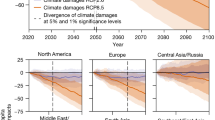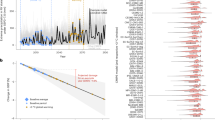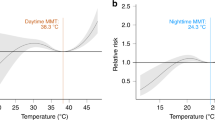Abstract
Urban water demand will increase by 80% by 2050, while climate change will alter the timing and distribution of water. Here we quantify the magnitude of these twin challenges to urban water security, combining a dataset of urban water sources of 482 of the world’s largest cities with estimates of future water demand, based on the Intergovernmental Panel on Climate Change (IPCC)’s Fifth Assessment scenarios, and predictions of future water availability, using the WaterGAP3 modelling framework. We project an urban surface-water deficit of 1,386–6,764 million m³. More than 27% of cities studied, containing 233 million people, will have water demands that exceed surface-water availability. An additional 19% of cities, which are dependent on surface-water transfers, have a high potential for conflict between the urban and agricultural sectors, since both sectors cannot obtain their estimated future water demands. In 80% of these high-conflict watersheds, improvements in agricultural water-use efficiency could free up enough water for urban use. Investments in improving agricultural water use could thus serve as an important global change adaptation strategy.
This is a preview of subscription content, access via your institution
Access options
Access Nature and 54 other Nature Portfolio journals
Get Nature+, our best-value online-access subscription
$29.99 / 30 days
cancel any time
Subscribe to this journal
Receive 12 digital issues and online access to articles
$119.00 per year
only $9.92 per issue
Buy this article
- Purchase on Springer Link
- Instant access to full article PDF
Prices may be subject to local taxes which are calculated during checkout





Similar content being viewed by others
References
UNDP. World Urbanization Prospects: The 2014 Revision (United Nations Population Division, New York, 2014).
Jiang, L. & O’Neill, B. C. Global urbanization projections for the shared socioeconomic pathways. Glob. Environ. Change 42, 193–199 (2017).
Flörke, M. et al. Domestic and industrial water uses of the past 60 years as a mirror of socio-economic development: a global simulation study. Glob. Environ. Change 23, 144–156 (2013).
Richter, B. D. et al. Tapped out: how can cities secure their water future? Water Policy 15, 335–363 (2013).
Amarasinghe, U. & Smakhtin, V. Global Water Demand Projections: Past, Present, and Future (IWMI, Colombo, 2014).
Wada, Y. et al. Modeling global water use for the 21st century: the Water Futures and Solutions (WFaS) initiative and its approaches. Geosci. Model Dev. 9, 175–222 (2016).
McDonald, R. I. et al. Water on an urban planet: urbanization and the reach of urban water infrastructure. Glob. Environ. Change 27, 96–105 (2014).
Li, E., Endter-Wada, J. & Li, S. Characterizing and contextualizing the water challenges of megacities. J. Am. Water Resour. Assoc. 51, 589–613 (2015).
Hallegatte, S., Green, C., Nicholls, R. J. & Corfee-Morlot, J. Future flood losses in major coastal cities. Nat. Clim. Change 3, 802–806 (2013).
McDonald, R. I. et al. Global urban growth and the geography of water availability, quality, and delivery. AMBIO 40, 437–446 (2011).
Revi, A. et al. in Climate Change 2014: Impacts, Adaptation, and Vulnerability (eds Field, C. B. et al.) 535–612 (Cambridge Univ. Press, Cambridge, 2014).
Collins, M. et al. in Climate Change 2013: The Physical Science Basis (eds Stocker, T. F. et al.) 1062–1087 (Cambridge Univ. Press, Cambridge, 2013).
Hanasaki, N. et al. A global water scarcity assessment under shared socio-economic pathway — Part 2: water availability and scarcity. Hydrol. Earth Syst. Sci. 17, 2393–2413 (2013).
Wada, Y., Gleeson, T. & Esnault, L. Wedge approach to water stress. Nat. Geosci. 7, 615–617 (2014).
Engel, K., Jockiel, D., Kraljevic, A., Geiger, M. & Smith, K. Big Cities. Big Waters. Big Challenges. Water in an Urbanizing World (WWF, Berlin, 2011).
Padowski, J. C. & Gorelick, S. M. Corrigendum: global analysis of urban surface water supply and vulnerability (2014 Environ. Res. Lett. 9, 104004). Environ. Res. Lett. 9, 119501 (2014).
Moss, R. H. et al. The next generation of scenarios for climate change research and assessment. Nature 463, 747–756 (2010).
van Vuuren, D. P. et al. A new scenario framework for climate change research: scenario matrix architecture. Clim. Change 122, 373–386 (2014).
van Vuuren, D. P. & Carter, T. R. Climate and socio-economic scenarios for climate change research and assessment: reconciling the new with the old. Clim. Change 122, 415–429 (2014).
Wimmer, F. et al. Modelling the effects of cross-sectoral water allocation schemes in Europe. Clim. Change 128, 229–244 (2015).
Eisner, S. et al. An ensemble analysis of climate change impacts on streamflow seasonality across 11 large river basins. Clim. Change 141, 401–417 (2017).
aus der Beek, T. et al. Modelling historical and current irrigation water demand on the continental scale: Europe. Adv. Geosci. 27, 79–85 (2010).
Richter, B. D., Davis, M. M., Apse, C. & Konrad, C. A presumptive standard for environmental flow protection. River Res. Appl. 28, 1312–1321 (2012).
Hoekstra, A. Y. et al. Global monthly water scarcity: blue water footprints versus blue water availability. PLoS ONE 7, e32688 (2012).
Gleeson, T., Wada, Y., Bierkens, M. & van Beek, L. Water balance of global aquifers revealed by groundwater footprint. Nature 488, 197–200 (2012).
BGR/UNESCO. Groundwater Resources of the World 1:25,000,000 (BGR, 2008); https://www.whymap.org
Gleick, P. H. Global freshwater resources: soft-path solutions for the 21st century. Science 302, 1524–1528 (2003).
Molden, D. et al. Improving agricultural water productivity: between optimism and caution. Agric. Water Manage. 97, 528–535 (2010).
Zhao, X. et al. Burden shifting of water quantity and quality stress from megacity Shanghai. Water Resour. Res. 52, 6916–6927 (2016).
Cosgrove, W. J. & Loucks, D. P. Water management: current and future challenges and research directions. Water Resour. Res. 51, 4823–4839 (2015).
Kiparsky, M., Sedlack, D. L., Thompson, B. H. Jr. & Truffer, B. The innovation deficit in urban water: the need for an integrated perspective on institutions, organizations, and technology. Environ. Eng. Sci. 30, 395–408 (2013).
Schneider, C., Flörke, M., Eisner, S. & Voss, F. Large scale modelling of bankfull flow: an example for Europe. J. Hydrol. 408, 235–245 (2011).
Verzano, K. et al. Modeling variable river flow velocity on continental scale: current situation and climate change impacts in Europe. J. Hydrol. 424–425, 238–251 (2012).
Lehner, B., Verdin, K. & Jarvis, A. New global hydrography derived from spaceborne elevation data. Eos. Trans. 89, 93–94 (2008).
Schneider, C., Flörke, M., De Stefano, L. & Petersen-Perlman, J. D. Hydrological threats for riparian wetlands of international importance — a global quantitative and qualitative analysis. Hydrol. Earth Syst. Sci. 21, 2799–2815 (2017).
Eisner, S. Comprehensive Evaluation of the WaterGAP3 Model across Climatic, Physiographic, and Anthropogenic Gradients. PhD thesis, Univ. Kassel (2016).
Döll, P. et al. Impact of water withdrawals from groundwater and surface water on continental water storage variations. J. Geodyn. 59–60, 143–156 (2012).
Shiklomanov, I. in World Water Scenarios: Analyzing Global Water Resources and Use (ed. Rijsberman, F. R.) Ch. 12, 160–203 (Earthscan Publications, London, 2000).
Utility Data Institute. World Electric Power Plants Data Base (Platts Energy InfoStore, 2004); https://infostore.platts.com/infostore/samples/descmeth.pdf
Flörke, M., Bärlund, I. & Kynast, E. Will climate change affect the electricity production sector? A European study. J. Water Clim. Change 3, 44–54 (2012).
Siebert, S., Henrich, V., Frenken, K. & Burke, J. Update of the Global Map of Irrigation Areas to Version 5 (University of Bonn, Bonn; FAO, Rome; 2013).
Siebert, S. et al. A global data set of the extent of irrigated land from 1900 to 2005. Hydrol. Earth Syst. Sci. 19, 1521–1545 (2015).
Rohwer, J., Gerten, D. & Lucht, W. Development of Functional Types of Irrigation for Improved Global Crop Modelling Report 104 (Potsdam Institute for Climate Impact Research, Potsdam, 2007).
Rost, S. et al. Agricultural green and blue water consumption and its influence on the global water system. Water Resour. Res. 44, W09405 (2008).
Alcamo, J. et al. Development and testing of the WaterGAP 2 global model of water use and availability. Hydrolog. Sci. J. 48, 317–337 (2003).
FAOSTAT. Live Animals and Livestock Primary, 2014. http://faostat.fao.org/site/339/default.aspx (FAO, 2014).
McDonald, R. I., Weber, K. F., Padowski, J., Boucher, T. & Shemie, D. Estimating watershed degradation over the last century and its impact on water-treatment costs for the world’s large cities. Proc. Natl Acad. Sci. USA 113, 9117–9122 (2016).
Balk, D. in Global Mapping of Human Settlement: Experiences, Data Sets, and Prospects (eds. Gamba, P. & Herold, M.) 145–161 (Taylor and Francis, New York, 2009).
CIESIN, Columbia University, IFPRI, World Bank, CIAT. Global Rural–Urban Mapping Project (GRUMP): Urban Extents (Center for International Earth Science Information Network, 2004); http://sedac.ciesin.columbia.edu/data/collection/grump-v1
O’Neill, B. C. et al. A new scenario framework for climate change research: the concept of shared socioeconomic pathways. Clim. Change 122, 387–400 (2014).
van Vuuren, D. P. et al. The representative concentration pathways: an overview. Clim. Change 109, 5–31 (2011).
Piani, C. et al. Statistical bias correction of global simulated daily precipitation and temperature for the application of hydrological models. J. Hydrol. 395, 199–215 (2010).
Hempel, S., Frieler, K., Warszawski, L., Schewe, J. & Piontek, F. A. Trend-preserving bias correction — the ISI-MIP approach. Earth Syst. Dyn. 4, 219–236 (2013).
Warszawski, L. et al. The inter-sectoral impact model intercomparison project (ISI-MIP): project framework. Proc. Natl Acad. Sci. USA 111, 3228–3232 (2014).
Masui, T. et al. An emission pathway for stabilization at 6 Wm−2 radiative forcing. Clim. Change 109, 59–76 (2011).
Wada, Y. et al. Multimodel projections and uncertainties of irrigation water demand under climate change. Geophys. Res. Lett. 40, 4626–4632 (2013).
Brauman, K. A., Richter, B. D., Postel, S., Malsy, M. & Flörke, M. Water depletion: an improved metric for incorporating seasonal and dry-year water scarcity into water risk assessments. Elem. Sci. Anth. 4, 83 (2016).
Poff, N. L. et al. The natural flow regime. Bioscience 47, 769–784 (1997).
Poff, N. L. & Zimmerman, J. K. H. Ecological responses to altered flow regimes: a literature review to inform the science and management of environmental flows. Freshw. Biol. 55, 194–205 (2010).
Acreman, M. C. et al. The changing role of ecohydrological science in guiding environmental flows. Hydrol. Sci. J. 59, 433–450 (2014).
Müller Schmied, H. et al. Sensitivity of simulated global-scale freshwater fluxes and storages to input data, hydrological model structure, human water use and calibration. Hydrol. Earth Syst. Sci. 18, 3511–3538 (2014).
Portmann, F. T., Döll, P., Eisner, S. & Flörke, M. Impact of climate change on renewable groundwater resources: assessing the benefits of avoided greenhouse gas emissions using selected CMIP5 climate projections. Environ. Res. Lett. 8, 024023 (2013).
Author information
Authors and Affiliations
Contributions
M.F. and R.I.M. designed the study, M.F. drafted the manuscript and performed the analyses. R.I.M. provided all information on basin transfers, C.S. implemented basin transfers into the model and prepared global gridded data of water availability and sectoral water uses. All authors discussed the results and contributed to the manuscript.
Corresponding author
Ethics declarations
Competing interests
The authors declare no competing financial interests.
Additional information
Publisher’s note: Springer Nature remains neutral with regard to jurisdictional claims in published maps and institutional affiliations.
Supplementary information
Supplementary Information
Supplementary Tables 1–6.
Rights and permissions
About this article
Cite this article
Flörke, M., Schneider, C. & McDonald, R.I. Water competition between cities and agriculture driven by climate change and urban growth. Nat Sustain 1, 51–58 (2018). https://doi.org/10.1038/s41893-017-0006-8
Received:
Accepted:
Published:
Issue Date:
DOI: https://doi.org/10.1038/s41893-017-0006-8
This article is cited by
-
Aquifer depletion exacerbates agricultural drought losses in the US High Plains
Nature Water (2024)
-
Unequal impact of climate warming on meat yields of global cattle farming
Communications Earth & Environment (2024)
-
IS-SAR: an irrigation scheduling web application for Hass avocado orchards based on Sentinel-1 images
Irrigation Science (2024)
-
Factors impacting water quality and quantity in rapidly expanding urban areas based on the DPSIR model: experiences and challenges from Addis Ababa City, Ethiopia
Environmental Science and Pollution Research (2024)
-
Scarcity and quality risks for future global urban water supply
Landscape Ecology (2024)



